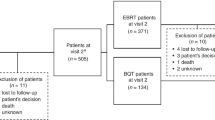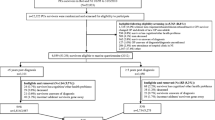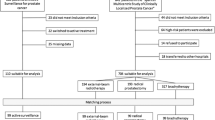Abstract
Purpose
To analyze the association between utility, treatment, and generic and prostate-specific health-related quality of life (HRQoL) among patients with prostate cancer.
Methods
In this longitudinal cohort study, we recruited 201 (≥45 years) newly diagnosed patients with prostate cancer from urology clinics of an urban academic hospital. Participants completed Quality of Wellbeing (QWB-SA), generic (SF-36), and prostate-specific (UCLA-PCI) HRQoL surveys prior to treatment and up to 24 months post-treatment. Clinical and demographic data were obtained via medical chart review, and utility scores were computed using QWB-SA. To analyze the relationship between treatment and utility, we used linear mixed effects models, after adjusting for covariates and propensity score. Similar models were used to examine the association between generic and prostate-specific HRQoL and utility.
Results
Mean baseline utility was comparable between radical prostatectomy (RP) and external beam radiation therapy (EBRT) groups (0.73 vs. 0.69, P = 0.1750). Mixed effects models indicated that RP was associated with higher utility at 24 month (OR = 1.12, P = 0.027), after controlling for covariates. RP was associated with improved functioning for role physical, role emotional, vitality, mental health and bodily pain, and impaired urinary function. Higher scores on generic health subscales were indicative of higher utility. Also, for prostate-specific HRQoL, higher scores on bowl function, sexual function, urinary bother, and bowel bother were associated with higher utility.
Conclusions
Treatment appears to have significant association with post-treatment utility. Thus, utility assessment provides an important quantitative tool to support patient and physician clinical treatment decision-making process in prostate cancer care.
Similar content being viewed by others
References
Jemal, A., Siegel, R., Ward, E., Hao, Y., et al. (2009). Cancer statistics, 2009. CA-A Cancer Journal for Clinicians, 59(4), 1–25.
Litwin, M. S., & Saigal, C. S. (ed). (2007). Urologic diseases in American. US Department of Health and Human Services, Public Health Service, National Institutes of Health, National Institute of Diabetes and Digestive and Kidney Diseases. Washington, DC: US Government Printing Office, 2007; NIH Publication No. 07-5512.
Borre, M., Nerstrom, B., & Overgaard, J. (1997). The dilemma of prostate cancer—A growing human and economic burden irrespective of treatment strategies. Acta Oncologica, 36(7), 681–687.
McNaughton-Collins, M., Walker-Corkery, E., & Barry, M. J. (2004). Health-related quality of life, satisfaction and economic outcome measures in studies of prostate cancer screening and treatment, 1990–2000. Journal of National Cancer Institute, Monographs, 33, 78–101.
Chan, J. M., Jou, R. M., & Carroll, P. R. (2004). The relative impact and future burden of prostate cancer in the United States. The Journal of Urology, 172, S13–S17.
Quek, M. L., & Penson, D. F. (2005). Quality of life in patients with localized prostate cancer. Urologic Oncology: Seminars and Original Investigations, 23, 208–215.
Jayadevappa, R., Chhatre, S., Bloom, B. S., et al. (2006). Health related quality of life and satisfaction with care among older men treated with radical prostatectomy or external beam radiation therapy. British Journal of urology International, 97, 955–962.
Sanda, M. G., Dunn, R. L., Michalski, J., et al. (2008). Quality of life and satisfaction with care outcome among prostate cancer survivors. New England Journal of Medicine, 358, 1250–1261.
Patrick, D. L., & Chiang, Y. P. (2000). Measurement of health outcomes in treatment effectiveness evaluations. Medical Care 38 (suppl II): II-14-II-25.
Fleming, G., Wasson, J. H., Albertsen, P. C., et al. (1993). A decision analysis of alternative treatment strategies for clinically localized prostate cancer. Journal of American Medical Association, 269(20), 2650–2658.
King, J. T., Tsevat, J., Lave, J. R., et al. (2005). Willingness to pay for a quality adjusted life year: Implications for societal health care resource allocation. Medical Decision Making, 25, 667–677.
Ware, J. E., Jr, & Sherbourne, C. D. (1992). The MOS 36-item short-form health survey (SF-36). Conceptual framework and item selection. Medical Care, 30, 473–483.
Stewart, A. L., Hays, R. D., Ware, J. E., Jr, et al. (1988). The MOS short form general health survey. Reliability and validity in a patient population. Medical Care, 26, 724–735.
Litwin, M. S., Hays, R. D., Fink, A., et al. (1998). The UCLA prostate cancer index: Development, reliability and validity of health-related quality of life measure. Medical Care, 36, 1002–1012.
Andersen, E. M. (1998). Performance of a self-administered mailed version of the quality of well-being (QWB-SA) questionnaire among older adults. Medical Care, 36(9), 1349–1360.
Kaplan, R. M., & Anderson, J. P. (1998). A general health policy model: Update and applications. Health Services Research, 23(2), 203–235.
Kaplan, R. M., Ganiats, T. G., Sieber, W. J., & Anderson, J. P. (1998). The quality of well-being scale: Critical similarities and differences with SF-36. International Journal for Quality in Health Care, 10(6), 509–520.
Charlson, M. E., Pompei, P., Ales, K. L., et al. (1987). A new method of classifying prognostic comorbidity in longitudinal studies: Development and validation. Journal of Chronic Disease, 40, 373–383.
Allison, P. D. (1999). Logistic regression using the SAS system: Theory and application. Cary, NC: SAS Institute Inc.
Greene, W. H. (2000). Econometric analysis (4th ed.). Upper Saddle River: Prentice Hall.
D’Agostino, R. B., Jr. (1998). Propensity score methods for bias reduction in the comparison of a treatment to a non-randomized control group. Statistics in Medicine, 17, 2265–2281.
Oakes, M. (1990). Statistical inference. Chestnut Hill, MA: Epidemiological Resources.
Engels, J. M., & Diehr, P. (2003). Imputation of missing longitudinal data: A comparison of methods. Journal of Clinical Epidemiology, 56, 968–976.
Lazzaro, C., Bartoletti, R., Guazzoni, G., et al. (2007). QuABIOS Study Group. Economic evaluation of different hormonal therapies for prostate cancer. Final results from the Quality of Life Antiandrogen Blockade Italian Observational Study (QuABIOS). Archivio Italiano di Urologia, Andrologia, 79(3), 104–107.
Sommers, B. D., Beard, C. J., D’Amico, A. V., et al. (2008). Predictors of patient preferences and treatment choice for localized prostate cancer. Cancer, 113, 2058–2067.
Bhatnagar, V., Stewart, S. T., Bonney, W. W., et al. (2004). Treatment options for localized prostate cancer: Quality-adjusted life years and the effects of lead time. Urology, 63, 103–109.
Stewart, S. T., Lenert, L., Bhatnagar, V., et al. (2005). Utilities for prostate cancer health states in men aged 60 and older. Medical Care, 43, 347–355.
Chen, R. C., Clark, J. A., & Talcott, J. A. (2009). ) Individualizing quality-of-life outcomes reporting how localized prostate cancer treatments after patients with different levels of baseline urinary, bowel and sexual function. Journal of Clinical Oncology, 27(24), 3916–3922.
Fumitaka, S., Katsuki, F., Yoichi, M. I., et al. (2008). Factors associated with variation in utility scores among patients with prostate cancer. Value in Health, 7(11), 1190–1193.
Krahn, M., Ritvo, P., Irvine, J., et al. (2003). Patient and community preferences for outcomes in prostate cancer. Medical Care, 41, 153–164.
Saigal, C. S., Gornbein, J., Reid, K., et al. (2002). Stability of time trade-off utilities for health states associated with the treatment of prostate cancer. Quality of Life Research, 11, 405–414.
Bremner, K. E., Chong, A. K. Y. C., Tomlinson, G., et al. (2007). A review and meta analysis of prostate cancer utilities. Medical Decision Making, 27, 288–298.
Saigal, C. S., Cornbein, J., Nease, R., et al. (2001). Predictors of utilities for health states in early stage prostate cancer. Journal of Urology, 166, 942–946.
Karin, S., Per, C., Gabriel, S., et al. (2004). The estimated economic value of the welfare loss due to prostate cancer pain in a defined population. Acta Oncologica, 43(3), 290–296.
Elkin, E. B., Cowen, M. E., Cahill, D., et al. (2004). Preference assessment method affects decision-analytic recommendations: A prostate cancer treatment example. Medical Decision Making, 24, 504–510.
Acknowledgments
Supported by the DOD Prostate Cancer Research Program W81XWH-04-1-0257.
Author information
Authors and Affiliations
Corresponding author
Rights and permissions
About this article
Cite this article
Jayadevappa, R., Schwartz, J.S., Chhatre, S. et al. Association between utility and treatment among patients with prostate cancer. Qual Life Res 19, 711–720 (2010). https://doi.org/10.1007/s11136-010-9622-8
Accepted:
Published:
Issue Date:
DOI: https://doi.org/10.1007/s11136-010-9622-8




